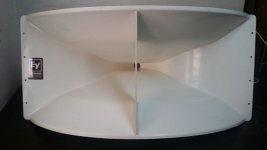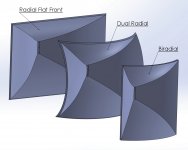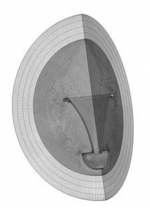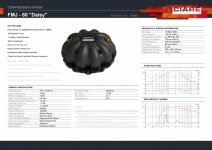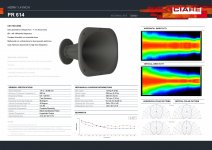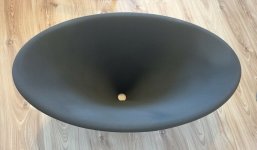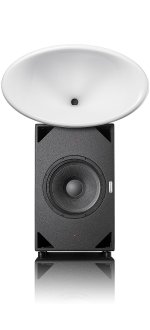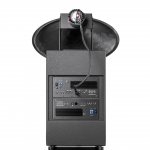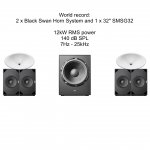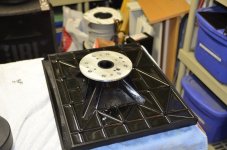In the next release of my tool you will be able to do that
Your tool is a great gift to the community.
I know you've put a lot of time and effort into STH/ATH.
Originally Posted by barossi
What about Mr Don Keele's electro voice horns like HR 6040A or the famous HR 9040A?
Originally Posted by Ro808
These represent the acme of CD horn design IMHO.
What do you mean by "acme"? To me we have moved way past those older designs.
A(nother) quote:
"Modern constant directivity horn design started with the work of D. B. (Don) Keele, Jr., John Gilliom, and Ray Newman at Electrovoice in the middle of the 1970s. Their work introduced the features that are the central methods for controlling directivity in all current horn design.
Their first design idea was a contraction in the throat immediately following the driver. This detail is emphasized in the White horn series they designed; however, the idea predates this horn (Keele, 1983). The narrow throat allowed the use of a larger driver and improved the directional control by letting the sound illuminate the sides of the horn, without the high-frequency beaming usually associated with larger throat sizes.
The second feature was a conical-exponential (CE) throat shape, which consisted of an exponential throat over a certain distance, after which there was a smooth transition into a conical (straight-sided) shape. The combination of these two curves allowed the control of low-frequency impedance by the use of the quasi-exponential throat expansion, and still maintained excellent directional coverage afforded by the conical shape of the sides.
The third step the group took was to address the problem of mid-range narrowing, present in most horns before this design. Their approach was to flare the mouth of the horn at a point, which was about two-thirds the distance from the beginning of the conical section to the mouth. The flare was added at an angle, which was about twice the angle of the original conical section. The added flare resulted in the high frequencies seeing one mouth size and the lower frequencies seeing another. The flare also allowed the transition between the horn mouth and the surrounding air to be less abrupt. The sound pressure distribution across the mouth of the horn was no longer constant but was higher in the center of the horn. The horn mouth no longer looked like a pure piston in a baffle and as a result the frequency narrowing problems (predicted by the piston model) that were associated with previous designs were no longer present.
The White horn series was highly successful. The design gave good horizontal directivity control without the mid-frequency beaming that had been associated with most previous horns. The vertical frequency control was not emphasized in the design in favor of a smaller vertical dimension. This shows the design tradeoff that is made between horn mouth height and the capability of controlling the vertical directivity over a wide range of frequencies. Because the vertical dimension of the mouth is relatively small, the frequency at which the vertical control begins is rather high—1.2 kHz. The White horn series was the first commercial product to be a true constant-directivity type."
Attachments
Last edited:
Ideally, such a phase plug would be simulated in the 'virtual' driver which is mounted to the (specific) horn.
This is how the big loudspeaker manufacturers develop their drivers and horns.
The driver in this case, is not your average lumped parameter/elements model, but an exact replica of the real thing.
For this reason, such models rarely leave the company, because in the wrong hands, these facilitate re-engineering.
Below is an example. It (still) looks sophisticated, but it's actually outdated.
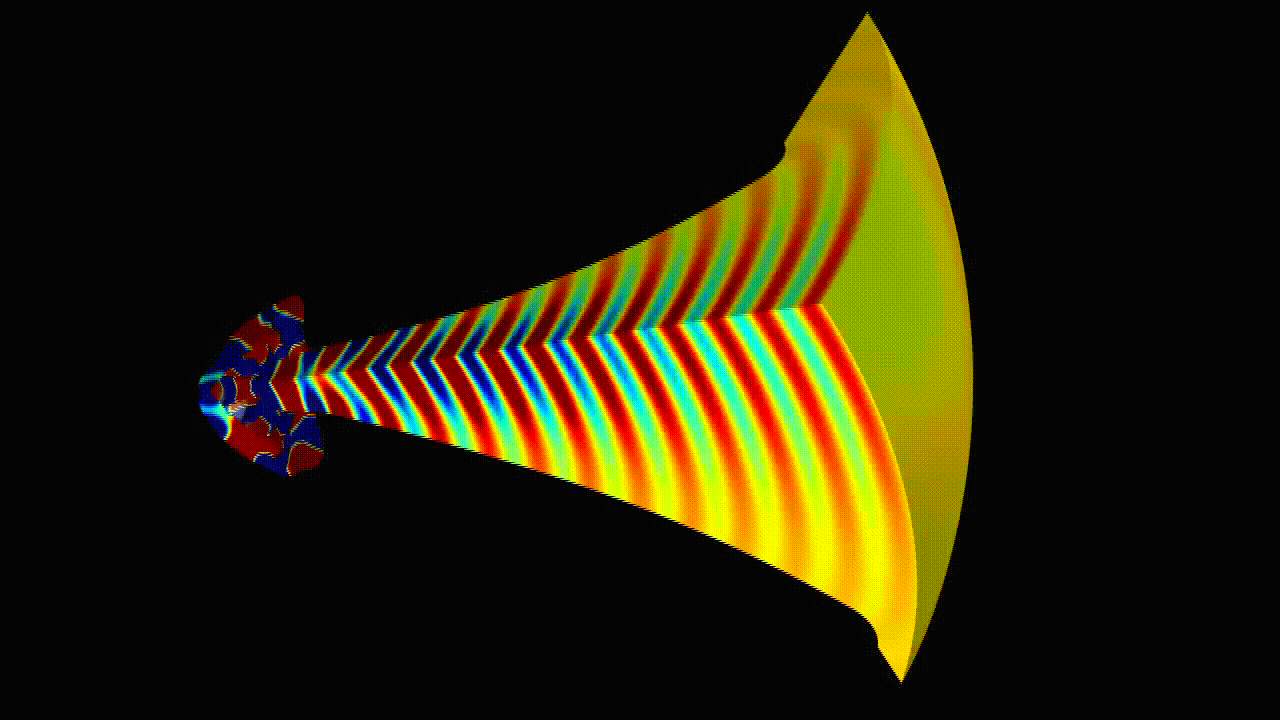
This is how the big loudspeaker manufacturers develop their drivers and horns.
The driver in this case, is not your average lumped parameter/elements model, but an exact replica of the real thing.
For this reason, such models rarely leave the company, because in the wrong hands, these facilitate re-engineering.
Below is an example. It (still) looks sophisticated, but it's actually outdated.

Last edited:
A(nother) quote:
"Modern constant directivity horn design started with the work of D. B. (Don) Keele, Jr., John Gilliom, and Ray Newman at Electrovoice in the middle of the 1970s.
"Modern"? 1970's - I'd really call that (well known, but outdated) "history." Everything has changed since back then.
If you shop smart, the driver + horn shown in the pressure propagation .gif can be had for a just over €100, instead of > €350.
These were developed by a guy who also co-designed drivers and horns for FaitalPro and 18Sound.
Therefore, I expect the LTH142 and XT1464 would also work well with this driver.
The mesh that was used for the sims + specsheets:
These were developed by a guy who also co-designed drivers and horns for FaitalPro and 18Sound.
Therefore, I expect the LTH142 and XT1464 would also work well with this driver.
The mesh that was used for the sims + specsheets:
Attachments
Last edited:
So what is the ultimate 'modern' designed horn to use for a 'big' 2-way setup (ie. to pair with 1x or 2x 15" bass drivers running upto 500-800hz)?
There's no such thing as 'ultimate' or 'one size fits all' in audio
It depends on your objectives/preferences, room, cabinet, compression driver etc. and budget vs ability to DIY.
If you want my opinion:
- For 800Hz, I would consider a (OS) waveguide
- For 500Hz, I would gravitate toward the (prototype) horns that jzagaya posted.
So what is the ultimate 'modern' designed horn to use for a 'big' 2-way setup (ie. to pair with 1x or 2x 15" bass drivers running upto 500-800hz)?
Yes, I would like to know too... The design I have now (JBL 2384 waveguide and 2453H-SL 4" large format driver with 1.5" exit) is from 2008 that sits on top of stacked 15" woofer crossed at 630 Hz. Sounds pretty good on and off axis as a constant directivity waveguide and I have posted the frequency response before.
But, as I say, that is from 2008, over 10 years ago. Aside from the KPT-402-HF, which is somewhat ubobtanium, I can't seem to find anything better. What do I mean better? Like you say, proper loading to down to 500/600 Hz, suitable for a 1.4 or 1.5" exit CD that can go that low, and extend to near 20 kHz. A constant directivity design (no "head in vice" please) with near perfect on and off axis response. And maybe a bit wider pattern than 90 x 50. The M2 waveguide appears to be a contender at 120 x 110 pattern, but seems to struggle below 1 kHz, both in pattern control and rising distortion, even though it is crossed at 800 Hz... No sure if that is the limitation of the 3" D2430K CD or waveguide or both?
Oh yeah and something one can either DIY or purchase would be nice
I fel like I'm running off on a tangent....ok, in XDIR
frequency 630hz
driver distance 431.8mm
woofer phase lag 0
woofer sum 0
Tweeter -300db
This is the polar I'd see from the 15" pair at crossover, spaced about 1" apart....correct? In the middle approximate middle of 30 and 60 degrees there's a huge null. At 30 degrees its -10db.
So as we lower the freq, things get better but...then theres the horn...we can't model for the horns polar can we? I can't even imagine how its polar interacts with the horn at xover...
So back to the issue with the dual 15's....One axis to about 15 degrees at 630hz we good. This polar represents 2 drivers and dead center of the drivers equals on axis I believe, so if I could angle the speakers to my ear this could work...
The directivity of the 15" is already increasing due to driver size, near xover, 2 woofers increase directivity by introducing nulls at 37 degrees which open back up as you get wider....I don't know what all these nulls do to the room energy, but lessen would be one....
These are meant to be a one man party for the critical listening, where a sweet spot is static.... if I can keep everything on axis by angling, what does the rest of the polar mean to me?
I now see the allure in MTM, and how the woofers spacing create a tight sweet spot without the need of angling the speakers as long as the T is at ear level. I dare say the polars are better...woofer wise, when they are stacked tighter together but now you must get the center of the pair at ear level , to which I suggested angling. If I remove the redundant coverage, the polars open right up...and now I am increasing the rooms energy once again....no? The high lobing is the high direcitivty is it not? As on axis is unaltered, an increasing amount of nulls off-axis, is the reduction of room energy....please correct me if I'm seeing this wrong. The one thing I see that isn't preferable is the off axis response colorization, its not exactly comparable to what a horn does is it.
MTM is starting to make sense, though I don't exactly understand how to predict comb filtering.
A mtm with a 23" horn in the middle would be about 76inches, just 2" under my ceilings XD......
I just about have no other option than to angle the pair or run them as mid and sub.
The jbl 4722 has this same lobing....how does it translate to the real world mitchba?
frequency 630hz
driver distance 431.8mm
woofer phase lag 0
woofer sum 0
Tweeter -300db
This is the polar I'd see from the 15" pair at crossover, spaced about 1" apart....correct? In the middle approximate middle of 30 and 60 degrees there's a huge null. At 30 degrees its -10db.
So as we lower the freq, things get better but...then theres the horn...we can't model for the horns polar can we? I can't even imagine how its polar interacts with the horn at xover...
So back to the issue with the dual 15's....One axis to about 15 degrees at 630hz we good. This polar represents 2 drivers and dead center of the drivers equals on axis I believe, so if I could angle the speakers to my ear this could work...
I design for the highest directivity that I can get in a reasonable size. The higher and flatter the DI(f) the better.
The directivity of the 15" is already increasing due to driver size, near xover, 2 woofers increase directivity by introducing nulls at 37 degrees which open back up as you get wider....I don't know what all these nulls do to the room energy, but lessen would be one....
These are meant to be a one man party for the critical listening, where a sweet spot is static.... if I can keep everything on axis by angling, what does the rest of the polar mean to me?
I now see the allure in MTM, and how the woofers spacing create a tight sweet spot without the need of angling the speakers as long as the T is at ear level. I dare say the polars are better...woofer wise, when they are stacked tighter together but now you must get the center of the pair at ear level , to which I suggested angling. If I remove the redundant coverage, the polars open right up...and now I am increasing the rooms energy once again....no? The high lobing is the high direcitivty is it not? As on axis is unaltered, an increasing amount of nulls off-axis, is the reduction of room energy....please correct me if I'm seeing this wrong. The one thing I see that isn't preferable is the off axis response colorization, its not exactly comparable to what a horn does is it.
MTM is starting to make sense, though I don't exactly understand how to predict comb filtering.
A mtm with a 23" horn in the middle would be about 76inches, just 2" under my ceilings XD......
I just about have no other option than to angle the pair or run them as mid and sub.
The jbl 4722 has this same lobing....how does it translate to the real world mitchba?
Last edited:
jzagaja has also developed this monster OS waveguide that would work from about 600Hz.
Attachments
jzagaja has also developed this monster OS waveguide that would work from about 600Hz.
Thanks, but I can't find any info on the device or if it is available separately from the system images posted.
camplo, you might want to reconsider modular cabs similar to the 'Beyond the Ariel' system that was discussed many pages ago.
That'll make experimenting with different setups a piece of cake.
The downside: no 10.5 ft3 cabs
BTW, the Black Swan cabs are also modular as shown in the pics.
That'll make experimenting with different setups a piece of cake.
The downside: no 10.5 ft3 cabs
BTW, the Black Swan cabs are also modular as shown in the pics.
Last edited:
So what is the ultimate 'modern' designed horn to use for a 'big' 2-way setup (ie. to pair with 1x or 2x 15" bass drivers running upto 500-800hz)?
The one you DIY.........no prosound horn is going to be 'ultimate' anything unless formed into a complete system like Dr. Geddes's speakers.
GM
MTM is starting to make sense, though I don't exactly understand how to predict comb filtering.
Vertical comb filtering is considered to be not as audible as horizontal one, so I guess you should start concerning about phantom center horizontal comb filtering from 2 stereo speakers before you concern about MTM lobing.
Mitch, your 2384s are still very good imo.
In the complete system the M2 wg is undoubtely a competent performer, but this only after a considerable amount of processing.
The wg+D2 and the woofer are not an ideal match.
It's no wonder the wg doesn't load the driver very well below 1000Hz, if you look at its depth, or lack thereof.
In the complete system the M2 wg is undoubtely a competent performer, but this only after a considerable amount of processing.
The wg+D2 and the woofer are not an ideal match.
It's no wonder the wg doesn't load the driver very well below 1000Hz, if you look at its depth, or lack thereof.
Attachments
Last edited:
The one you DIY.........no prosound horn is going to be 'ultimate' anything unless formed into a complete system like Dr. Geddes's speakers.
GM





...But a remark has to be made.
A loudspeaker system is more than just the horn.
Throughout the thread we've discussed systems with supposedly bad horns, that are top class nonetheless.
The Strauss SE-MF-2 being an example.
Last edited:
- Home
- Loudspeakers
- Multi-Way
- Is it possible to cover the whole spectrum, high SPL, low distortion with a 2-way?
